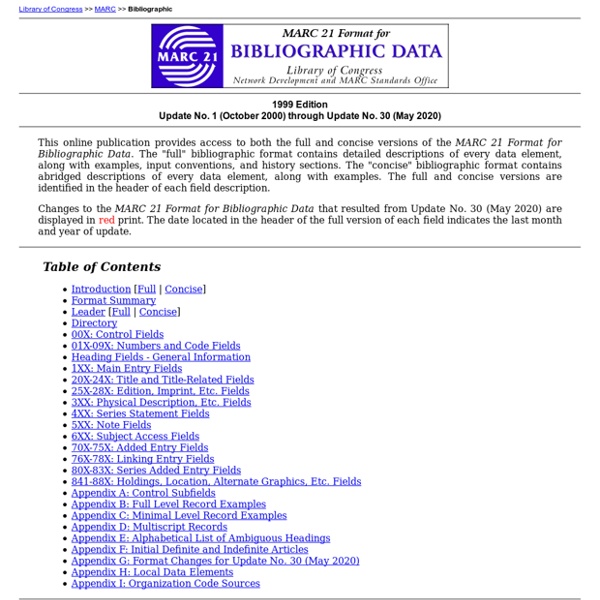MARC 21 Format for Bibliographic Data: Table of Contents (Network Development and MARC Standards Office, Library of Congress)
1999 Edition Update No. 1 (October 2000) through Update No. 20 (April 2015) This online publication provides access to both the full and concise versions of the MARC 21 Format for Bibliographic Data. The "full" bibliographic format contains detailed descriptions of every data element, along with examples, input conventions, and history sections. The "concise" bibliographic format contains abridged descriptions of every data element, along with examples. The full and concise versions are identified in the header of each field description. Changes to the MARC 21 Format for Bibliographic Data that resulted from Update No. 20 (April 2015) are displayed in red print. Table of Contents
http://www.loc.gov/marc/bibliographic/
Library of Congress Classification Outline - Classification - Cataloging and Acquisitions
skip navigation Suggestions enabled. The Library of Congress > Cataloging, Acquisitions > Classification > Library of Congress Classification Outline
Catalogs, Authority Records - Cataloging and Acquisitions (Library of Congress)
skip navigation Suggestions enabled. The Library of Congress > Cataloging, Acquisitions > Catalogs, Authority Records
an Experimental Classification Service
Enter an ISBN, OCLC#, UPC, or ISSN Standard Number: An ISBN is a unique number assigned to an item by its publisher. Each ISBN is a 10 or 13 digit number. Thirteen-digit ISBNs must begin with either 978 or 979. Enter ISBNs with our without hyphens.
Understanding MARC Bibliographic: Machine-Readable Cataloging
Understanding MARC Bibliographic: Machine-Readable Cataloging Written by Betty Furrie in conjunction with the Data Base Development Department of The Follett Software Company Eighth edition reviewed and edited by the Network Development and MARC Standards Office, Library of Congress Published by the Network Development and MARC Standards Office, Library of Congress Available from:
Take RDA Toolkit for a Spin: RDA Toolkit Free Trial
Informed decisions are typically better decisions. To insure that you are fully aware of all the features and benefits of RDA Toolkit and prepared to make the best possible decision for your institution, we are happy to offer the RDA Toolkit Free Trial. This offer includes one-time, 30-day access to RDA Toolkit and is available to everyone. Take a close look at what RDA Toolkit has to offer. It is fully searchable (even by AACR2 rule number) and includes integrated Library of Congress Policy Statements, mappings to MARC and AACR2, both Table of Contents and Element Set views of RDA, and tools to customize your organization's instruction program and procedures.
Arranging library fiction by genre
Traditionally, fiction in a library is arranged by the author’s surname from A to Z. However, another approach worth considering is arranging fiction alphabetically within smaller genre sections in your school library. Contents Possible advantages and disadvantagesDefining genreFiction genres in a school libraryProcess of changing the fiction collection arrangementPromoting genre to studentsFurther information and resources
Card Tricks: The Decline & Fall of a Bibliographic Tool – Circulating Now from NLM
By Stephen J. Greenberg ~ There was a time, not so very long ago, when card catalogues were pretty much synonymous with libraries. You really could not imagine one without the other. As late as the 1960s, some library buildings were architecturally designed around their physical catalogues. The current main building of the National Library of Medicine is a good example.
Resource Description & Access (RDA)
SCIS Schools Catalogue Information Service
Have you ever wondered why some SCIS records contain two similar or identical subject headings? SCIS cataloguers use two controlled vocabularies: the SCIS Subject Heading List (SCISSHL) and the Schools Online Thesaurus (ScOT). You’ll notice that the codes ‘scisshl’ or ‘scot’ appear in parentheses after each heading, representing which vocabulary the heading came from. Subscribers who access records through SCISWeb have the option to have headings from both vocabularies in their downloaded records, or just their preferred one. These two controlled vocabularies serve complementary functions.
Practical guidance for any librarian learning to deal with data
Facet Publishing have announced the release of The Data Librarian’s Handbook by Robin Rice and John Southall. This new book, written by two data librarians with over 30 years’ experience, unpicks the everyday role of the data librarian and offers practical guidance on how to collect, curate and crunch data for economic, social and scientific purposes. Interest in data has been growing in recent years. Support for this peculiar class of digital information – its use, preservation and curation, and how to support researchers’ production and consumption of it in ever greater volumes to create new knowledge, is needed more than ever.
Related:
Related:



